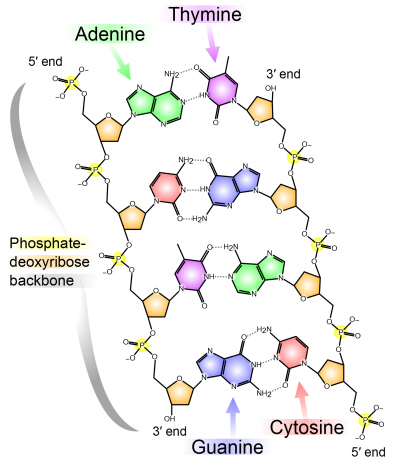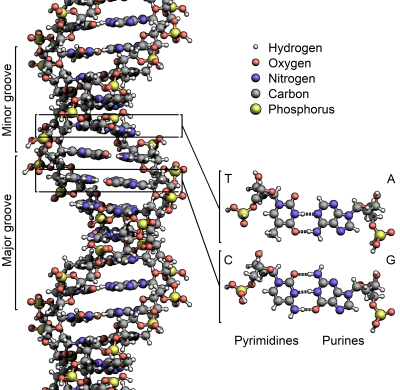Difference between revisions of "DNA"
(→Exceptions) |
|||
| Line 13: | Line 13: | ||
=Exceptions= | =Exceptions= | ||
| − | RNA and proteins in the cellular environment are also passed on in the cell. Furthermore, cultural traditions (e.g., adult milk consumption) that may or may not be related to genetic variation (e.g., lactose tolerance) are also passed on within families. (Humans are also not the only extant species with cultural inheritance.) Both of these examples can be argued to also represent transmission of | + | RNA and proteins in the cellular environment are also passed on in the cell. Furthermore, cultural traditions (e.g., adult milk consumption) that may or may not be related to genetic variation (e.g., lactose tolerance) are also passed on within families. (Humans are also not the only extant species with cultural inheritance.) Both of these examples can be argued to also represent transmission of hereditary information. |
Viruses with an RNA genome are another exception to the rule above. | Viruses with an RNA genome are another exception to the rule above. | ||
Revision as of 12:50, 16 July 2014
DNA contains the vast majority of genetic information that is transmitted between generations in the form of a base pair sequence (see the exceptions below).
DNA is made up of a sequence (polymer) of four major base pairs (A, C, G, and T). (C can be methylated, changing its function.) (Synthetic base pairs have been created that also function as a part of a DNA sequence.) These nitrogenous bases are covalently bonded to a deoxyribose sugar, which in turn is bound to a phosphate group. The phosphate group is also bound to the next sugar forming an alternating deoxyribose-sugar backbone supporting the base pair sequence.
DNA is typically present in the cell as doubled anti-parallel (running in opposite directions) strands that are connected with hydrogen bonds according to the base pairing rule (A-T and C-G). By convention only a single sequence of DNA is written down (because the alternate strand can be fully determined from one sequence) and it is written in the 5' to 3' direction (referring to the orientation of the sugar groups in the sugar-phosphate backbone) unless specifically indicated otherwise. Thus, 5'-ATGCATGC-3' is equivalent to ATGCATGC or (on the opposite strand) GCATGCAT. ATGCATGC is not equivalent to 3'-ATGCATGC-5'.
DAPI is a commonly used fluorescent stain of DNA to detect the presence of DNA in various samples.
Exceptions
RNA and proteins in the cellular environment are also passed on in the cell. Furthermore, cultural traditions (e.g., adult milk consumption) that may or may not be related to genetic variation (e.g., lactose tolerance) are also passed on within families. (Humans are also not the only extant species with cultural inheritance.) Both of these examples can be argued to also represent transmission of hereditary information.
Viruses with an RNA genome are another exception to the rule above.
Prions (infectious protein conformations) are also an exception to the rule above.

